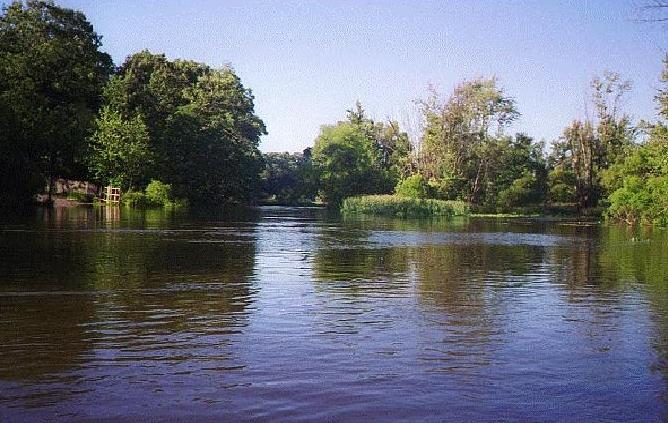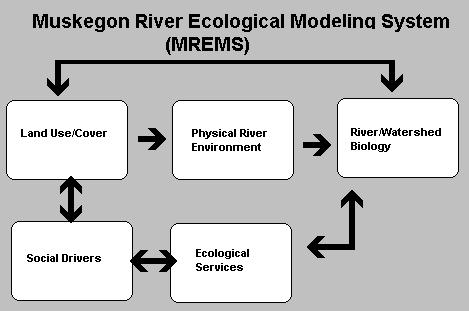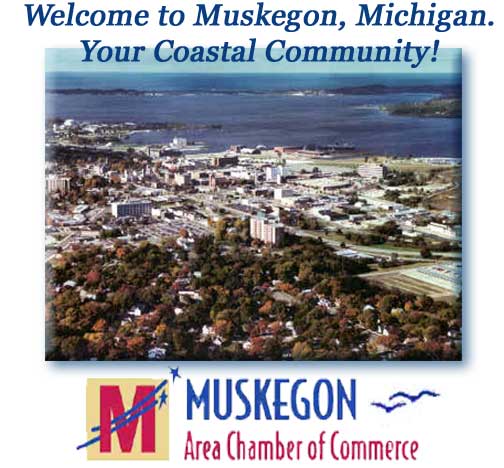A Collaborative Approach to Understanding the Dynamics of the Muskegon Watershed: A Comprehensive Model, Risk Assessment and Tools for Use in Management
Bryan C. Pijanowski, Michigan State University;
John Koches, Grand Valley State University;
Paul. W. Seelbach, Michigan Department of Natural Resources, Fisheries Division
Project Overview
Watershed management programs across Michigan
suffer from the lack of an integrated analysis grounded in meaningful collaborations
among governmental agencies, academic institutions, and local stakeholders.
On the Muskegon, as elsewhere, there currently is no effort underway that
will provide a process for the holistic integration of all that is currently
known about the watershed from the head waters to the river's outlet to
Lake Michigan. 
Many environmental and economic problems
facing the citizens of this important watershed require an understanding
of the interactions of key components: the watershed's human communities,
land use/cover patterns, hydrogeology, and complex natural communities.
Changes in land use occurring within the watershed are diverse and are
driven by internal factors (e.g., planning, local economics), as well as
external factors (demand for seasonal homes, climate change, global agricultural
economics). These changes need to be quantified, and their effects understood,
and assessed. Hydrology of the watershed is in turn being modified by changes
in land cover (e.g., increase in impervious surfaces, aforestation patterns).
As well as by climate variation, sediment loading, artificial drainage,
and channel impoundment. Natural biological communities (e.g., fish, birds,
stream macrophytes) respond to both direct and indirect alterations in
hydrology and resulting habitat structure. Ultimately, changes on the landscape
trigger complex responses in the chemistry and biology of the river. The
watershed's ecological and social services, which emerge from the integration
of all watershed components, are poorly understood but are critical considerations
in any regional decision making. All of these ecosystem components need
to be understood and related in a risk assessment framework so that managers
and citizens of the Muskegon watershed can make important decisions about
the future.
Approach
We are combining the considerable wealth of data,
experience and tools that already exist in Michigan through ongoing efforts
at the University of Michigan, Michigan State University and Grand Valley
State University and their partners in state government (MDEQ, MDNR) to
assess current status and future risks facing the Muskegon River Watershed.
This collaborative research effort is unique in it's scale of collaboration
and draws upon the diverse talents in many different organizations. 
Expected Outcomes
Specific outcomes that we anticipate are: (1) a new integrated set of models that can serve as the basis for discussion, hypothesis testing and further research development; (2) a formal risk assessment that examines the relative severity of important problems facing the watershed such as urban sprawl, sedimentation and impoundment; (3) a linkage of process-based models to ecological services assessment, and (4) a number of internet-based tools and model products. We believe that these outcomes will be relevant to all citizens of the watershed and help to advance the science necessary for integrated assessment of watersheds and Ecosystem Management.
SNRE Staff and Student Researchers
Mike Wiley, Paul Seelbach, Paul Richards, Catherine Riseng, Mike Moore, Ed Rutherford, Martha Carlson, Kevin Cronk, Beth Sparks-Jackson, Matt Baker, Steve Hensler, Sara Creque
Other SNRE Projects Associated with the Muskegon River Initiative
Ecological Assessment and Monitoring Program Development: [GLFT/MSU] Mike Wiley, Catherine Riseng, &
Institutional Framework for Watershed Policy and Management [Wege Foundation/Ferris State] Terry Brown, Julia Wondolleck, Donna Erickson
Salmonine Recruitment dynamics in the lower Muskegon: [GLFT/UM] Ed Rutherford
Perch Recruitment dynamics in the Lower Muskegon: [GLFT/UM] David Jude
Riparian ecosystem classification and dynamics: [MDNR/UM] Mike Wiley, Matt Bake, Paul Seelbach


